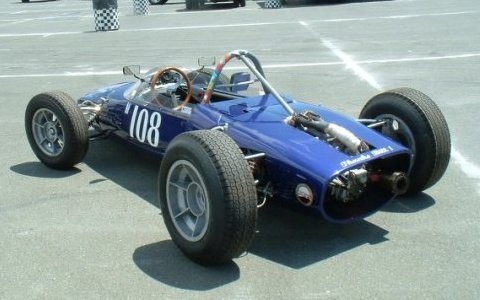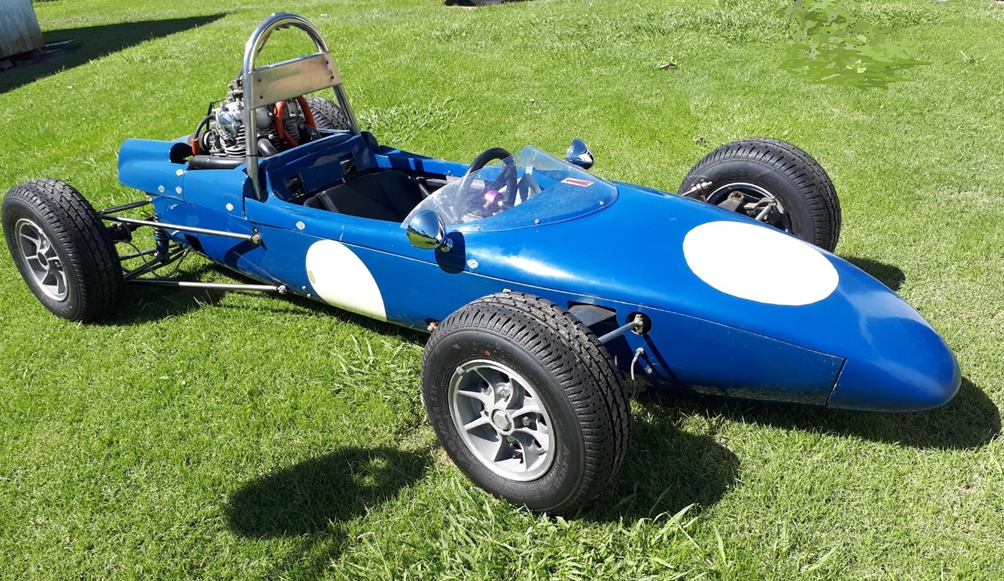by Richard Anderson
At Loose Fillings we must admit to only being vaguely aware of something called Formula 4 which in a way superseded the pioneering British 500cc Formula 3. We are also aware of a 125cc movement that briefly flourished in Australia about which we someday hope to write; anyone care to make sense of the stack of Clisby photos we have? Now Richard Anderson has written to us from New Zealand with news of his rare 1967 Briham Formula 4.
In Britain the first alternative to 500cc racing was a 250cc formula that started in the early 1950s. The class first ran at a semi-private meeting at Brands Hatch on 17 April 1955 and the 250 MCR ran its own meetings at Brands Hatch in 1955/56 before joining up with the Austin 7 originating 750 Motor Club. The last outing of these cars was in July 1963 when two of them ran in one of the last UK 500cc races at a 750MC Silverstone meeting.
Click below for a classic bit of British newsreel from 1966 on what came next:
Everybody’s Racing Car (1966 )
This was Formula 4, and Richard has sent us the history below by Mark Wenden in UK who can probably be regarded as ‘Mr F4′ being the owner of a number of F4 Cars and all the drawings, blueprints etc for the Johnny Walker cars mentioned below.
Formula 4 racing can trace its origins back to 1962 in the US where the first F4 races were held. The cars were typically scaled replicas of Fl cars and powered by 250cc motorcycle engines. It didn’t take too long for the idea to be brought to Britain by American servicemen working in Europe, and in 1963 Trak-kart built the 500cc Triumph-engined TK. As the concept gathered momentum in Europe in 1965, Tecnokart in Italy began producing the Tecno which was powered by 250cc Ducati engines, (below)

In the same year, the first Johnny Walker cars appeared from their Gloucestershire factory with the JW4 Mk1 powered by the 250cc Villiers Starmaker. Johnny Walker was better known at the time for operating a bearings and machine tool business. He had a keen interest in motor sports and saw the potential of Formula 4 after their first car emanated from someone who had approached them with a design into which they built in the Villiers engine.
The car initially competed against 750MC cars, and with the interest this created, Johnny Walker Racing Ltd was subsequently born. They then entered negotiations with the RAC and FIA for the formula to be officially recognized. The first car, the Mk1, was the 250cc but it proved to be slow and unreliable, so the 650cc Mk2 was born with a BSA engine. Reportedly it was capable of 120mph around Castle Combe.
One of the conditions of the new formula was that the smallest class cars should have a basic price (complete with engine) of less than £650. The regulations allowed for 3 classes which were 250cc and 650cc using motorcycle engines, and 875cc which used car-derived engines. Engines from Ducati, Villiers, Husqvarna and Bultaco predominated. The Johnny Walker Mk3 & Mk4 JW4’s were fitted with 875cc Imp and Saab engines. All the classes were tightly controlled for cost and engine tuning.
Initially the grids were small, but for 1967 and 1968 they had a series of about 7 rounds which included the British Grand Prix meeting at Silverstone in 1967. Notable works drivers for JW4’s were Bev Bond and Derek Minter who had switched to four wheels following his retirement from motorcycle racing.
The most prolific manufacturer was the Italian Techno company which produced a Ducati 250cc-engined car. A significant number of cars were produced by Tark (Estonia) though these probably didn’t compete outside the Soviet block. From Spain came the Nogeura with Bultaco engines, along with numerous others produced in small numbers.
In the USA ‘Red’ LeGrand produced cars with the 700cc BMW engine and transmission, below.

In the UK by far the largest producer was Johnny Walker who produced approximately 50 cars. Also from UK were Vixen, Evad, Ginetta, Briham, along with many owner-built one-off cars. Unfortunately, just as Formula 4 was starting to get going, Johnny Walker’s firm suddenly went into liquidation. This left Techno as the only major manufacturer and a handful of smaller companies producing specials.
Enter Briham: in 1966 the brothers Brian & Peter Hampsheir built a Villiers Starmaker 250cc engined-car to meet the RAC specifications. The car was extremely light thanks to its innovative use of Mallite sandwich construction. Mallite was a product produced primarily for the aircraft industry and comprised a sandwich of end-grain balsa wood laminated between two sheets of thin duralium. Extremely strong and very light in weight, McLaren used Mallite in the construction of the M2B, their first Fl car.
Formula 4 racing ended soon after. but the cars lived on by adapting to compete in many different countries, and in 1970 the 750MC took Formula 4 under its wing by amending the regulations to allow for 1000cc engines and aerodynamic devices.
The Hampsheir’s car used the material in a completely different way, with a top panel and 4 bulkheads dropping from it, then bonding the “monocoque” in a fibreglass shell using steel reinforcements for suspension (explain better). It was exhibited at the Racing Car Show in January 1967 and then the car was modified to take a 650cc Triumph (pre unit) engine and Norton gearbox, (it was re-designated as PRH4).
The car proved to be extremely quick and was very advanced with rocker-arm front suspension and inboard coil-overs front and rear; it tipped the scales at about 220kg. This prototype car was invariably on the front row of the starting grid, however lack of reliability of the old Triumph engine reduced the number of chequered flags it received.
The brothers then set about producing 5 cars (designated PRH4, 2-6) al1 of which were fitted with the later Triumph Bonneville engine and exported to the USA via Jan Winkel of WREP inc, their US distributor. My car’s early history is unknown, but we do know that it is car number PRH4-3 (the second of the exported cars) The original Triumph engine had been removed early in its life and replaced with a Yamaha XS650 engine of 1975 vintage.
With 5 gears, more horsepower, electric start, and no oil leaks it is a worthy successor to the old Triumph. The engine bares the insignia of Anderson-Robinson who modified these engines, as “streetracker” engines. I do not know what modifications have been made but the engine certainly has some punch.
PRH4-3 has been recommissioned with new brakes, chain & sprocket, wheel cylinders, 6 point harness, the original 10″ sized ‘wheels (in place of the 13″ minilites) fitted with new tyres, and is pretty much ready to go racing.

Richard Anderson’s Briham F4
Editor’s Note: see also https://loosefillings.com/2017/03/29/masterly-modern-interpretation/ for Bob Britton’s contribution to the art

G’day Richard Anderson,
Regarding the CLISBY and the “125 Movement in Australia”.
We believe that there are only two remaining CLISBY “Screaming Blowflies” around, and they are still in Adelaide.
One owned now by Ms. A. Clisby, and originally owned and driven my James (Jimmy) E. Gosse. The other is owned now by me, Jim Scammell, and was originally owned and driven by Lindsay (Fred) LeMessurier.
Those two blokes were the best of mates in the Sporting Car Club of South Australia, along with a couple of other close mates, Freeman and Sheppard, who each owned a ‘CLISBY 125’.
Between Ms. Clisby, me and the Sporting Car Club, I’m sure that you could get a lot of information on the “125 Movement”. And we could help you out with the photos.
Rgds Jim Scammell
LikeLike
Great article, buddy. Our resident race car driver Daniel has been competing in Formula Vee for two years now and we LOVED seeing the vintage open-wheel machinery in your post.
.
Bravo.
LikeLike
You are most welcome; keep watching for more oddities.
LikeLiked by 1 person
Jim Scammel, could you please email me a contact to follow uo the Clisby story – I dont have an address for you
LikeLike